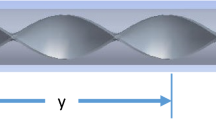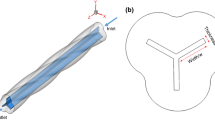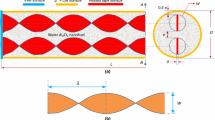Abstract
In this study, fluid flow of the Al2O3/ethylene glycol (EG) nanofluid in a corrugated tube fitted with twisted tapes were experimentally studied under turbulent flow conditions. The experiments with different twists ratio and different nanofluid concentration were performed under similar operation condition. The investigated ranges are (1) three different Al2O3 concentrations: 0.5, 1 and 1.5 % by volume (2) three different twist ratios of twisted tape: y/w = 2, 3.6 and 5 and (3) Reynolds number from 6000 to 30,000. Regarding the experimental data, utilization of twists together with nanofluids tends to increase heat transfer and friction factor as compared with the base fluid. In addition, heat transfer performances were weakened by using for high nanoparticle concentration. The thermal performances of the heat exchanger with nanofluid and twisted tapes were evaluated for the assessment of overall improvement in thermal behavior. Over the range studied, the maximum thermal performance factor 4.2 is found with the use of Al2O3/EG nanofluid at concentration of 0.5 % by volume in corrugated tube together with twisted tape at twist ratio of 2.










Similar content being viewed by others
Abbreviations
- Cp :
-
Specific heat at constant pressure (J kg−1 K−1)
- di :
-
Inside diameter of the test tube (m)
- e:
-
Helical corrugation depth
- f:
-
Friction factor
- h:
-
Heat transfer coefficient (W m−2 K−1)
- k:
-
Thermal conductivity of fluid (W m−1 K−1)
- L:
-
Length of the test section (m)
- n:
-
Shape factor
- Nu:
-
Nusselt number
- Re:
-
Reynolds number
- t:
-
Temperature (°C)
- TR:
-
Twist ratio
- w:
-
Tape width (m)
- y:
-
Tape pitch length (m)
- d:
-
Tape thickness (m)
- ρ:
-
Fluid density (kg m−3)
- μ:
-
Fluid dynamic viscosity (kg s−1 m−1)
- η:
-
Thermal enhancement index
- ∆:
-
Bruggeman model parameter
- Ψ:
-
Sphericity
- b:
-
Base fluid
- nf:
-
Nanofluid
- np:
-
Nanoparticle
- NE:
-
Non enhanced
- E:
-
Enhanced
References
Bergles AE (1985) Techniques to augment heat transfer. In: Roshenow WM et al (eds) Hand book of heat transfer applications, 2nd edn. McGraw-Hill, New York
Khanafer K, Vafai K, Lightstone M (2003) Buoyancy driven heat transfer enhancement in a two-dimensional enclosure utilizing nano-fluids. Int J Heat Mass Transf 46:3639–3653
Duangthongsuk W, Wongwises S (2009) Heat transfer enhancement and pressure drop characteristics of TiO2–water nanofluid in a double-tube counter flow heat exchanger. Int J Heat Mass Transf 52:2059
Choi SUS (1995) Development and applications of non-Newtonian flows. ASME, New York
Pak BC, Cho YI (1998) Hydrodynamic and heat transfer study of dispersed fluids with submicron metallic oxide particles. Exp Heat Transf 11:151
Eastman JA, Choi SUS, Li S, Thompson LJ (1997) Enhanced thermal conductivity through the development of nanofluids. In: Proceedings of the symposium on nanophase and nanocomposite materials II, vol 457, Materials Research Society, USA, pp 3–11
Li Q, Xuan Y (2002) Convective heat transfer and flow characteristics of Cu–water nanofluid. Sci China E 45:408
Xuan Y, Li Q (2003) Investigation on convective heat transfer and flow features of nanofluids. ASME J Heat Transf 125:151
Wen D, Ding Y (2004) Experimental investigation into convective heat transfer of nanofluids at the entrance region under laminar flow conditions. Int J Heat Mass Transf 47:5181
Murshed SMS, Leong KC, Yang C (2005) Enhanced thermal conductivity of TiO2–water based nanofluids. Int J Therm Sci 44:367–373
Heris SZ, Etemad SG, Esfahany MN (2006) Experimental investigation of oxide nanofluids laminar flow convective heat transfer. Int Commun Heat Mass Transf 33:529
Heris SZ, Esfahany MN, Etemad SG (2007) Experimental investigation of convective heat transfer of Al2O3/water nanofluid in circular tube. Int J Heat Fluids Flow 28(2):203
Santra AK, Sen S, Chakraborty N (2008) Study of heat transfer augmentation in a differentially heated square cavity using copper–water nanofluid. Int J Therm Sci 47:1113–1122
Nguyen CT, Roy G, Gauthier C, Galanis N (2007) Heat transfer enhancement using Al2O3–water nanofluid for electronic liquid cooling system. Appl Therm Eng 28:1501
Chun BH, Kang HU, Kim SH (2008) Effect of alumina nanoparticles in the fluid on heat transfer in double-pipe heat exchanger system. Korean J Chem Eng 25(5):966–971
Duangthongsuk W, Wongwises S (2008) Effect of thermophysical properties models on the prediction of the convective heat transfer coefficient for low concentration nanofluid. Int Commun Heat Mass Transf 35:1320
Santra AK, Sen S, Chakraborty N (2009) Study of heat transfer due to laminar flow of copper–water nanofluid through two isothermally heated parallel plates. Int J Therm Sci 48:391–400
Namburu PK, Das DK, Tanguturi KM, Vajjha RS (2009) Numerical study of turbulent flow and heat transfer characteristics of nanofluids considering variable properties. Int J Therm Sci 48:290–302
Gherasim I, Roy G, Nguyen CT, Vo-Ngoc D (2009) Experimental investigation of nanofluids in confined laminar radial flows. Int J Therm Sci 48:1486–1493
Duangthongsuk W, Wongwises S (2010) An experimental study on the heat transfer performance and pressure drop of TiO2–water nanofluids flowing under a turbulent flow regime. Int Commun Heat Mass Transf 53:334–344
Hojjat M, Etemad SGh, Bagheri R, Thibault J (2011) Convective heat transfer of non-Newtonian nanofluids through a uniformly heated circular tube. Int J Therm Sci 50:525–531
Hojjat M, Etemad SG, Bagheri SGR, Thibault J (2011) Rheological characteristics of non-Newtonian nanofluids: experimental investigation. Int Commun Heat Mass Transf 38:144–148
Heidary H, Kermani MJ (2012) Heat transfer enhancement in a channel with block(s) effect and utilizing nano-fluid. Int J Therm Sci 57:163–171
Pelević N, van der Meer TH (2012) Numerical investigation of the effective thermal conductivity of nano-fluids using the lattice Boltzmann model. Int J Therm Sci 62:154–159
Fakoor-Pakdaman M, Akhavan-Behabadi MA, Razi P (2013) An empirical study on the pressure drop characteristics of nanofluid flow inside helically coiled tubes. Int J Therm Sci 65:206–213
Wang XQ, Mujumdar AS (2007) Heat transfer characteristics of nanofluids: a review. Int J Therm Sci 46:1–19
Godson L, Raja B, Mohan Lal D, Wongwises S (2009) Enhancement of heat transfer using nanofluids—an overview. Renew Sustain Energy Rev 14:629–641
Nguyen CT, Desgranges F, Galanis N, Roy G, Maré T, Boucher S (2008) Viscosity data for Al2O3–water nanofluid—hysteresis: is heat transfer enhancement using nanofluids reliable? Int J Therm Sci 47:103–111
Chang SW, Jan YJ, Liou JS (2007) Turbulent heat transfer and pressure drop in tube fitted with serrated twisted tape. Int J Therm Sci 46:506–518
Wongcharee K, Eiamsa-ard S (2011) Friction and heat transfer characteristics of laminar swirl flow through the round tubes inserted with alternate clockwise and counter-clockwise twisted-tapes. Int Commun Heat Mass Transf 38:348–352
Manglik RM, Bergles AE (1993) Heat transfer and pressure drop correlations for twisted tape inserts in isothermal tubes: part I—laminar flows. Trans ASME J Heat Transf 115:881–889
Manglik RM, Bergles AE (1993) Heat transfer and pressure drop correlations for twisted-tape inserts in isothermal tubes, part II: transition and turbulent flows. Trans ASME J Heat Transf 115:890–896
Sarma PK, Subrahmanyam T, Kishore PS, DharmaRao V, Kakac S (2002) A new method to predict convective heat transfer in a tube with twisted tape inserts for turbulent flow. Int J Therm Sci 41:955–960
Sarma PK, Kishore PS, DharmaRao V, Subrahmanyam T (2005) A combined approach to predict friction coefficients a d convective heat transfer characteristics in A tube with twisted tape inserts for a wide range of Re and Pr. Int J Therm Sci 44:393–398
Naphon P (2006) Heat transfer and pressure drop in the horizontal double pipes with and without twisted tape insert. Int Commun Heat Mass Transf 33:166–175
Eiamsa-ard S, Thianpong C, Eiamsa-ard P, Promvonge P (2010) Thermal characteristics in a heat exchanger tube fitted with dual twisted tape elements in tandem. Int Commun Heat Mass Transf 37:39–46
Eiamsa-ard S, Thianpong C, Eiamsa-ard P (2010) Turbulent heat transfer enhancement by counter/co-swirling flowin a tube fitted with twin twisted tapes. Exp Therm Fluid Sci 34:53–62
Eiamsa-ard S, Seemawute P, Wongcharee K (2010) Influences of peripherally-cut twisted tape insert on heat transfer and thermal performance characteristics in laminar and turbulent tube flows. Exp Therm Fluid Sci 34:711–719
Eiamsa-ard S, Promvonge P (2010) Performance assessment in a heat exchanger tube with alternate clockwise and counter-clockwise twisted-tape inserts. Int J Heat Mass Transf 53:1364–1372
Guo J, Fan A, Zhang X, Liu W (2011) A numerical study on heat transfer and friction factor characteristics of laminar flow in a circular tube fitted with center-cleared twisted tape. Int J Therm Sci 50:1263–1270
Zhang X, Liu Z, Liu W (2012) Numerical studies on heat transfer and flow characteristics for laminar flow in a tube with multiple regularly spaced twisted tapes. Int J Therm Sci 58:157–167
SyamSundar L, Sharma KV (2010) Turbulent heat transfer and friction factor of Al2O3 nanofluid in circular tube with twisted tape inserts. Int J Heat Mass Transf 53:1409–1416
Suresh KP, Venkitaraj P, Selvakumar M (2012) Chandrasekar, A comparison of thermal characteristics of Al2O3/water and CuO/water nanofluids in transition flow through a straight circular duct fitted with helical screw tape inserts. Exp Therm Fluid Sci 39:37–44
Wongcharee K, Eiamsa-ard S (2012) Heat transfer enhancement by using CuO/water nanofluid in corrugated tube equipped with twisted tape. Int Commun Heat Mass Transf 39:251–257
Maxwell JC (1954) Treatise on electricity and magnetism. Dover, New York
Hamilton RL, Crosser OK (1962) Thermal conductivity of heterogeneous two component systems. I&EC Fundam 1(3):187
Yu W, Choi SUS (2003) The role of interfacial layer in the enhanced thermal conductivity of nanofluids: a renovated Maxwell model. J Nanoparticles Res 5:167–171
Bruggeman DAG (1935) Berechnung verschiedener physikalischer konstanten von heterogenen substanzen, I. Dielektrizitatskonstanten und Leitfahigkeiten der Mischkorper aus Isotropen Substanzen. Ann Phys 14:636
Timofeeva EV, Gavrilov AN, McCloskey JM, Tolmachev YV (2007) Thermal conductivity and particle agglomeration in alumina nanofluids: experiment and theory. Phys Rev 76:061203
Einstein A (1911) Berichtigung zu meiner Arbeit: eine neue Bestimmung der Molekuldimensionen. Ann Phys 34:591
Author information
Authors and Affiliations
Corresponding author
Appendix: Uncertainty analysis
Appendix: Uncertainty analysis
The uncertainty table for different instruments used in experiment is given in Table 2. The maximum possible error for the parameters involved in the analysis are estimated and summarized in Table 3.
Reynolds number, Re:
Heat transfer rate of the nanofluid:
Heat transfer rate of the water:
Nusselt number, Nu:
Friction factor, f:
Rights and permissions
About this article
Cite this article
Mohammadiun, H., Mohammadiun, M., Hazbehian, M. et al. Experimental study of ethylene glycol-based Al2O3 nanofluid turbulent heat transfer enhancement in the corrugated tube with twisted tapes. Heat Mass Transfer 52, 141–151 (2016). https://doi.org/10.1007/s00231-015-1550-2
Received:
Accepted:
Published:
Issue Date:
DOI: https://doi.org/10.1007/s00231-015-1550-2




